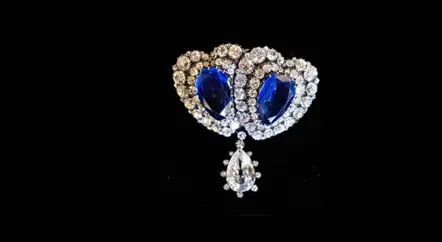Yorkshire-based artist, Bethan Maddocks, has been commissioned by Chatsworth House Trust to research and develop new artwork for this year's Christmas at Chatsworth: Palace of Advent. Bethan’s resulting work, The Caretakers, can be found in the Chapel Corridor and responds to the theme of Angels.
Developed over eight months, Bethan spent time visiting Chatsworth, delving into the archive and exploring artwork in the Devonshire Collections to gain inspiration for her work.
In response, she has created two intricately designed papercut artworks exploring the untold stories of Chatsworth's caretakers, or guardian angels, from the past; the dedicated and hard-working labourers that enabled Chatsworth to continue to support the estate and wider community during some of the most challenging periods in history.
Shining a light on figures such as gardeners, groundsmen, housekeepers and cooks, Bethan has used archival material including receipts, diary entries, letters and photographs to inform the imagery in her work.
Visitors might seek out vulture feather dusters, found in an early 20th-century sales catalogue in the archive; radishes, peaches and rhubarb, as indicated in seed merchant receipts from 1883; or the historic glasshouse in the garden, cut to replicate a staff photograph taken in 1895.
"Deep diving into the archives with the collections team, I wanted to find stories of the historic workers so that the work was led by an authentic ‘voice’.
"Although many workers' names weren’t recorded, only written in the ledgers as ‘day labourers’, I was able to tell their stories through the receipts for tools they would have used for their jobs. I also wanted to allude to the changing face of the workers, such as women starting work in the garden during World War I as the male workforce went to war. Items such as World War I rifles can be found...in the decorative borders of the artwork, and tomatoes can be seen growing from the rifles – these are the plants Chatsworth House began to grow and sell at market as part of their war effort."
Bethan was drawn to the story of individuals such as Ada Booth who worked in the kitchens. Ada sometimes appears in the account books as a charwoman (a cleaner), and sometimes as a dairy maid. However, in a letter written by the 9th Duke’s Chief Agent, Roland Burke, in 1921, her main duties were described in greater detail:
(Ada)...has always given out the milk, plucked game and cooked for the servants during board wages, or for the family during short visits. I think she also prepared vegetables.[1]
Bethan represents the diversity of Ada’s role in her artwork, a milk caddy can be seen at the top left of the paper-cut house, brushes and dusters to the right of the house and the plucking shears depicted around the birds. Bethan was interested in the hard labour of plucking game for a feast for the gentry, and the birds falling feathers offer a connection to the theme of angels and service via this unseen labour.
The composition of the piece as a whole reflects the structure of tapestries in the Devonshire Collections and a visit to see old master drawings, including works by Cornelius Titian, Henry Rochler and Albrecht Durer have inspired the central figure of the angel in both works. However, in Bethan’s final paper cuts, we notice that the robes, inspired by Titian’s angel in the work ‘The Annunciation’ (c.1488), have been switched for the aprons and workwear emblematic of historic staff uniforms.
Bethan is an award-winning artist known for creating meaningful, socially engaged, site-specific work. She works with archives, communities and collections to tell stories through her meticulously detailed work.
Following the commission, Bethan was awarded a micro-residency at Yorkshire Art Space in Sheffield, where she has been able to make the impressive two-metre-tall artworks in a supportive environment, whilst sharing her progress with visitors to the studio.
"Each piece is hand-cut from one single piece of paper - a balance of working out what I can cut without losing the integrity of the paper whilst making decorative, delicate imagery from archival research.
"The cutting of both pieces took six weeks. Although I had a rough idea of what the work would look like, each day I started on a new area slowly cutting away new elements, trying to find symbols to tell stories of labour, links to empire, class, wealth and service, uncovering and revealing these stories with the aid of my trusty scalpel."
Surrounded by historic depictions of angels in paintings from the Devonshire Collection on the Chapel Corridor, Bethan’s work stands as a tribute to the many unseen guardian angels of Chatsworth’s history, telling a story of dedication, hard work and care, spanning several centuries.
"Within my arts practice, I aim to explore and tell untold stories of people, places and land. Whilst precisely cutting the windows, cutlery and candlesticks in ‘The Caretakers’ I thought of the busy hands who would have polished and cleaned all these beautifully decorative objects, all the while having to use different corridors and staircases so that their work was kept out of sight.
"The work aims to elevate the important, yet oft unseen, labour of the working classes and also connects to contemporary celebrations at this time of year, where even in everyday houses there is so much hidden work, often by women; tidying the house, preparing birds and feasts, wrapping presents, and caring for others."
[1] 108/1/2 U.R. Burke Chief Agent’s Papers Re. Servants for the Duke & Duchess’s return from Canada. Letter from Roland Burke to Mrs Young, Housekeeper, 21.05.1921






